Cellulose Fibers-Based Porous Lightweight Foams for Noise Insulation
Abstract
1. Introduction
1.1. State of the Art in Materials Based on Cellulose Fibers and Foam Forming
1.2. Aim of This Study
2. Materials and Methods
2.1. About Materials
2.1.1. Cellulose-Based Foam-Formed Materials
2.1.2. Commercial Sound Absorbers
2.2. Methods Used for Forming Samples
2.2.1. Foam-Forming Method
2.2.2. Drying Methods
2.3. Methods for Investigation of Noise Insulation Ability
3. Results
3.1. Cellulose Fiber-Based Porous Lightweight Materials
3.2. Noise Insulation Characteristics
4. Discussion
5. Conclusions
Author Contributions
Funding
Institutional Review Board Statement
Data Availability Statement
Acknowledgments
Conflicts of Interest
References
- Leppänen, M.; Väätäinen, P. Environmental impact of cellulose-based insulation materials. Energy Build. 2018, 166, 246–254. [Google Scholar]
- Ruan, J.; Tang, S.; Dai, J. Research on sound absorption property of natural cellulose fiber. In Proceedings of the 2018 2nd International Conference on Composite Material, Polymer Science and Engineering (CMPSE), Osaka, Japan, 21–22 September 2018; IEEE: Piscataway, NJ, USA, 2018; pp. 242–245. [Google Scholar]
- Acikgoz, S. Noise and Vibration Control Engineering: Principles and Applications; John Wiley & Sons: Hoboken, NJ, USA, 2016. [Google Scholar]
- Torgal, F.; Jalali, S. Eco-Efficient Construction and Building Materials: Life Cycle Assessment (LCA), Eco-Labelling and Case Studies; Woodhead Publishing: Thorston, UK, 2017. [Google Scholar]
- Tarnawski, W.; Krucinska, I. Acoustic properties of natural insulation materials. Arch. Acoust. 2017, 42, 103–110. [Google Scholar]
- Jaeger, P. Insulation materials for buildings. In Handbook of Environmental Engineering; Springer: Berlin/Heidelberg, Germany, 2014; pp. 111–136. [Google Scholar]
- Jahangiri, P. Novel Cellulose Based Foam-Formed Products: Applications and Numerical Studies. Ph.D. Thesis, University of British Columbia, Vancouver, BC, Canada, 2013. [Google Scholar]
- Madani, A.; Zeinoddini, S.; Varahmi, S. Turnbull, T.; Phillion, A.B.; Olson, J.A.; Martinez, D.M. Ultra-lightweight paper foams: Processing and properties. Cellulose 2014, 21, 2023–2031. [Google Scholar]
- Jahangiri, P.; Madani, A.; Korehei, R.; Zeinoddini, S.S.; Madani, A.; Sharma, Y.; Phillion, A.; Martinez, D.M.; Olson, J.A. On filtration and heat insulation properties of foam formed cellulose based materials. Nord. Pulp Pap. Res. J. 2014, 29, 584–591. [Google Scholar]
- Acikgoz, S.; Durgun, I. A new acoustic absorber material from cotton and polyurethane foam wastes. Build. Environ. 2008, 43, 1626–1633. [Google Scholar]
- Tianjian, L. Ultralight porous metals: From fundamentals to applications. Acta Mech. Sin. 2002, 18, 457–479. [Google Scholar]
- Tanpichai, S.; Boonmahitthisud, A.; Soykeabkaew, N.; Ongthip, L. Review of the recent developments in all-cellulose nanocomposites: Properties and applications. Carbohydr. Polym. 2022, 286, 119192. [Google Scholar] [CrossRef]
- Sombatsompop, N.; Niamsuwan, V. Acoustical properties of wood-based materials. In Wood in Civil Engineering; Springer: Berlin/Heidelberg, Germany, 2012; pp. 153–177. [Google Scholar]
- Joutsimo, O.P.; Tyrväinen, P. The effect of fiber properties on sound absorption of soft fiberboards. Appl. Acoust. 2014, 77, 17–24. [Google Scholar]
- Sahin, T.; Yılmaz, H. Sound absorption properties of wood-based insulation materials. J. Acoust. Soc. Am. 2016, 140, 3043. [Google Scholar]
- Akıncı, T.C. Evaluation of sound absorption properties of natural fiber materials. J. Nat. Fibers 2018, 15, 336–349. [Google Scholar]
- Kim, H.C.; Lee, J.W.; Kim, J.H. Acoustic absorption property of porous polymer materials made of vegetable fibers. J. Mech. Sci. Technol. 2012, 26, 2595–2601. [Google Scholar]
- Chen, N.; Pan, Q. Versatile fabrication of ultralight magnetic foams and application for oil-water separation. ACS Nano 2013, 7, 6875–6883. [Google Scholar] [CrossRef] [PubMed]
- Yin, J.; Li, X.; Zhou, J.; Guo, W. Ultralight three-dimensional boron nitride foam with ultralow permittivity and superelasticity. Nano Lett. 2013, 13, 3232–3236. [Google Scholar] [CrossRef] [PubMed]
- Xu, S.; Bourham, M.; Rabiei, A. A novel ultra-light structure for radiation shielding. Mater. Des. 2010, 31, 2140–2146. [Google Scholar] [CrossRef]
- Tillotson, T.M.; Hrubesh, L.W. Transparent ultralow-density silica aerogels prepared by a two-step sol-gel process. J. Non-Cryst. Solids 1992, 145, 44–50. [Google Scholar] [CrossRef]
- Tappan, B.C.; Huynh, M.H.; Hiskey, M.A.; Chavez, D.E.; Luther, E.P.; Mang, J.T.; Son, S.F. Ultralow-density nanostructured metal foams: Combustion synthesis, morphology, and composition. J. Am. Chem. Soc. 2006, 128, 6589–6594. [Google Scholar] [CrossRef]
- Radvan, B.; Gatward, A. Formation of wet-laid webs by a foaming process. Tappi 1972, 55, 748. [Google Scholar]
- Smith, M.; Punton, V. The role of the forming process in determining the structure and properties of paper. Pulp Pap. Can. 1975, 76, 114–117. [Google Scholar]
- Tringham, R. New developments in radfoam process. Pap. Technol. Ind. 1974, 15, 288–294. [Google Scholar]
- Smith, M.; Punton, V.; Rixson, A. Structure and properties of paper formed by a foaming process. Tappi 1974, 57, 107–111. [Google Scholar]
- Al-Qararah, A.M.; Hjelt, T.; Kinnunen, K.; Beletski, N.; Ketoja, J.A. Exceptional pore size distribution in foam-formed fibre networks. Nord. Pulp Pap. Res. J. 2012, 27, 226–230. [Google Scholar] [CrossRef]
- Cervin, N.T.; Andersson, L.; Ng, J.B.S.; Olin, P.; Bergström, L.; Wågberg, L. Lightweight and strong cellulose materials made from aqueous foams stabilized by nanofibrillated cellulose. Biomacromolecules 2013, 14, 503–511. [Google Scholar] [CrossRef] [PubMed]
- Deng, M.; Zhou, Q.; Du, A.; van Kasteren, J.; Wang, Y. Preparation of nanoporous cellulose foams from cellulose-ionic liquid solutions. Mater. Lett. 2009, 63, 1851–1854. [Google Scholar] [CrossRef]
- Sehaqui, H.; Salajkova, M.; Zhou, Q.; Berglund, L.A. Mechanical performance tailoring of tough ultra-high porosity foams prepared from cellulose I nanober suspensions. Soft Matter 2010, 6, 1824. [Google Scholar] [CrossRef]
- Ali, Z.M.; Gibson, L.J. The structure and mechanics of nanofibrillar cellulose foams. Soft Matter 2013, 9, 1580–1588. [Google Scholar] [CrossRef]
- Mohammadi, B.; Ershad-Langroudi, A.; Moradi, G.; Safaiyan, A.; Kahnamuei, F.H. Foam for Sound Insulation. In Polymeric Foams: Applications of Polymeric Foams (Volume 2); ACS Symposium Series; American Chemical Society: Washington, DC, USA, 2023; Volume 1440, Chapter 12; pp. 253–272. [Google Scholar] [CrossRef]
- Dua, S.; Khatri, H.; Naveen, J.; Jawaid, M.; Jayakrishna, K.; Norrrahim, M.N.F.; Rashedi, A. Potential of natural fiber based polymeric composites for cleaner automotive component production—A comprehensive review. J. Mater. Res. Technol. 2023, 25, 1086–1104. [Google Scholar] [CrossRef]
- Tauhiduzzaman, M.; Hafez, I.; Bousfield, D.; Tajvidi, M. Multiscale modeling of lignocellulosic foams under compression. Mater. Des. 2023, 225, 111471. [Google Scholar] [CrossRef]
- Hasan, A.; Rabbi, M.S.; Billah, M. Making the lignocellulosic fibers chemically compatible for composite: A comprehensive review. Clean. Mater. 2022, 4, 100078. [Google Scholar] [CrossRef]
- Yan, W.; Liu, J.; Zheng, X.; Zhang, J.; Tang, K. Wood-derived high-performance cellulose structural materials. e-Polymers 2023, 23, 20230010. [Google Scholar] [CrossRef]
- Xu, W.; Horoshenkov, K.V.; Jin, Y. The influence of a thin, natural cellulose fibre membrane on the acoustic absorption of a layer of melamine foam. Build. Acoust. 2023, 30, 1–16. [Google Scholar] [CrossRef]
- Ketola, A.E.; Song, W.; Lappalainen, T.; Salminen, K.; Viitala, J.; Turpeinen, T.; Miettinen, A.; Lee, K.-Y.; Ketoja, J.A. Changing the Structural and Mechanical Anisotropy of Foam-Formed Cellulose Materials by Affecting Bubble−Fiber Interaction with Surfactant. ACS Appl. Polym. Mater. 2022, 4, 7685–7698. [Google Scholar] [CrossRef]
- Keranen, J.T.; Jetsu, P.; Turpeinen, T.; Koponen, A.I. Dewatering and Structural Analysis of Foam-Formed, Lightweight Fibrous Materials. BioResources 2023, 18, 531–549. [Google Scholar] [CrossRef]
- Ergun, M.E. Activated Carbon and Cellulose-reinforced Biodegradable Chitosan Foams. BioResources 2023, 18, 1215–1231. [Google Scholar] [CrossRef]
- Ferreira, E.S. Insulative wood materials templated by wet foams. Mater. Adv. 2023, 4, 641–650. [Google Scholar] [CrossRef]
- Cucharero, J.; Ceccherini, S.; Maloney, T.; Lokki, T. Sound absorption properties of wood-based pulp fibre foams. Cellulose 2021, 28, 4267–4279. [Google Scholar] [CrossRef]
- Hjelt, T.; Ketoja, J.A.; Kiiskinen, H.; Koponen, A.I.; Pääkkönen, E. Foam forming of fiber products: A review. J. Dispers. Sci. Technol. 2022, 43, 1462–1497. [Google Scholar] [CrossRef]
- Miranda-Valdez, I.Y.; Coffeng, S.; Zhou, Y.; Viitanen, L.; Hu, X.; Jannuzzi, L.; Puisto, A.; Kostiainen, M.A.; Mäkinen, T.; Koivisto, J. Foam-formed biocomposites based on cellulose products and lignin. Cellulose 2023, 30, 2253–2266. [Google Scholar] [CrossRef]
- Nechita, P.; Nastac, S.M. Overview on Foam Forming Cellulose Materials for Cushioning Packaging Applications. Polymers 2022, 14, 1963. [Google Scholar] [CrossRef] [PubMed]
- Sriprom, W.; Sirivallop, A.; Choodum, A.; Limsakul, W.; Wongniramaikul, W. Plastic/Natural Fiber Composite Based on Recycled Expanded Polystyrene FoamWaste. Polymers 2022, 14, 2241. [Google Scholar] [CrossRef]
- Zhou, Y.; Yin, W.; Guo, Y.; Qin, C.; Qin, Y.; Liu, Y. Green Preparation of Lightweight, High-Strength Cellulose-Based Foam and Evaluation of Its Adsorption Properties. Polymers 2023, 15, 1879. [Google Scholar] [CrossRef]
- Taiwo, E.M.; Yahya, K.; Haron, Z. Potential of Using Natural Fiber for Building Acoustic Absorber: A Review. J. Phys. Conf. Ser. 2019, 1262, 012017. [Google Scholar] [CrossRef]
- Maderuelo-Sanz, R. Characterizing and modelling the sound absorption of the cellulose acetate fibers coming from cigarette butts. J. Environ. Health Sci. Eng. 2021, 19, 1075–1086. [Google Scholar] [CrossRef] [PubMed]
- Arenas, J.P.; Rebolledo, J.; del Rey, R.; Alba, J. Sound absorption properties of unbleached cellulose loose-fill insulation material. BioResources 2014, 9, 6227–6240. [Google Scholar] [CrossRef]
- Hurtado, P.L.; Rouilly, A.; Maréchal, V.V.; Raynaud, C. A review on the properties of cellulose fibre insulation. Build. Environ. 2016, 96, 170–177. [Google Scholar] [CrossRef]
- Silviana, S.; Prastiti, E.C.; Hermawan, F.; Setyawan, A. Optimization of the Sound Absorption Coefficient (SAC) from Cellulose–Silica Aerogel Using the Box–Behnken Design. ACS Omega 2022, 7, 41968–41980. [Google Scholar] [CrossRef]
- Neri, M.; Levi, E.; Cuerva, E.; Pardo-Bosch, F.; Zabaleta, A.G.; Pujadas, P. Sound Absorbing and Insulating Low-Cost Panels from End-of-Life Household Materials for the Development of Vulnerable Contexts in Circular Economy Perspective. Appl. Sci. 2021, 11, 5372. [Google Scholar] [CrossRef]
- Cheng, F.; Lu, P.; Ren, P.; Chen, J.; Ou, Y.; Lin, M.; Liu, D. Preparation and properties of foamed cellulose-polymer microsphere hybrid materials for sound absorption. BioResources 2016, 11, 7394–7405. [Google Scholar] [CrossRef][Green Version]
- Maderuelo-Sanz, R.; García-Cobos, F.J.; Sánchez-Delgado, F.J. Study of the acoustic performance of composites made from recycled cellulose acetate and polymer waste. Build. Acoust. 2022, 29, 445–457. [Google Scholar] [CrossRef]
- Krucińska, I.; Gliścińska, E.; Michalak, M.; Ciechańska, D.; Kazimierczak, J.; Bloda, A. Sound-absorbing green composites based on cellulose ultra-short/ultra-fine fibers. Text. Res. J. 2015, 85, 646–657. [Google Scholar] [CrossRef]
- Kolya, H.; Jang, E.S.; Hashitsume, K.; Kang, C.W. Effects of ammonium persulfate on coconut wood (Cocos nucifera L.) cellulose, hemicellulose, and lignin polymers: Improved sound absorption capacity. J. Appl. Polym. Sci. 2022, 139, e52674. [Google Scholar] [CrossRef]
- Nechita, P.; Nastac, S. Foam-formed cellulose composite materials with potential applications in sound insulation. J. Compos. Mater. 2018, 52, 747–754. [Google Scholar] [CrossRef]
- Debeleac, C.; Nechita, P.; Nastac, S. Computational investigations on soundproof applications of foam-formed cellulose materials. Polymers 2019, 11, 1223. [Google Scholar] [CrossRef] [PubMed]
- Stanciu, M.D.; Curtu, I.; Cosereanu, C.; Lica, D.; Nastac, S. Research regarding acoustical properties of recycled composites. In Proceedings of the 8th International DAAAM Baltic Conference Industrial Engineering, Tallinn, Estonia, 19–21 April 2012; Otto, T., Ed.; Tallinn University of Technology, Estonia: Tallinn, Estonia, 2012; pp. 741–746. [Google Scholar]
- Ionescu, S.; Nechita, P. Thermo-Insulating Panels Based on Composite Structures from Vegetal Fibres and Polymeric Matrix. Adv. Mater. Res. 2017, 1143, 154–159. [Google Scholar]
- Nastac, S.; Debeleac, C.; Nechita, P. Assessments on Shock Absorption Properties of Foam-Formed Low Density Cellulose Composites. Acta Tech. Napoc. Ser.-Appl. Math. Mech. Eng. 2017, 60, 565–572. [Google Scholar]
- Stanciu, M.D.; Savin, A.; Nastac, S.M. Mechanical and surface properties of lignocellulosic fibres reinforced composites. Stroj. Vestn 2018, 64, 698–705. [Google Scholar] [CrossRef]
- Nastac, S.; Nechita, P.; Debeleac, C.; Simionescu, C.; Seciureanu, M. The Acoustic Performance of Expanded Perlite Composites Reinforced with Rapeseed Waste and Natural Polymers. Sustainability 2022, 14, 103. [Google Scholar] [CrossRef]
- Seciureanu, M.; Guiman, M.V.; Nastac, S.M.; Nechita, P.; Debeleac, C.N.; Capatana, G.F. On Experimental Evaluation of Tortuosity for Cellulose-based Highly Porous Composites used within Noise Insulation Applications. In Proceedings of the 17th International Conference “Acoustics and Vibration of Mechanical Structures”, Springer Proceedings in Physics, Timisoara, Romania, 26–27 May 2023. [Google Scholar]
- Nechita, P.; Seciureanu, M.; Guiman, M.V. Sandwich Biocomposites Structures based on Foam and Cellulose Fibers intended to Noise Insulation. In Proceedings of the 24th International Symposium in the Fields of Pulp, Paper, Packaging and Graphics, Belgrade, Republic of Serbia, 21–22 June 2023. [Google Scholar]
- Seciureanu, M. Innovative Bio-Foam-Formed Composites for Soundproofing Applications. In Proceedings of the 29th International Congress on Sound and Vibration ICSV29, Prague, Czech Republic, 9–13 July 2023. [Google Scholar]
- Farrell, W.R. Acoustical Materials for Use in Monumental Spaces. Noise Control 1958, 4, 32–39. [Google Scholar] [CrossRef]


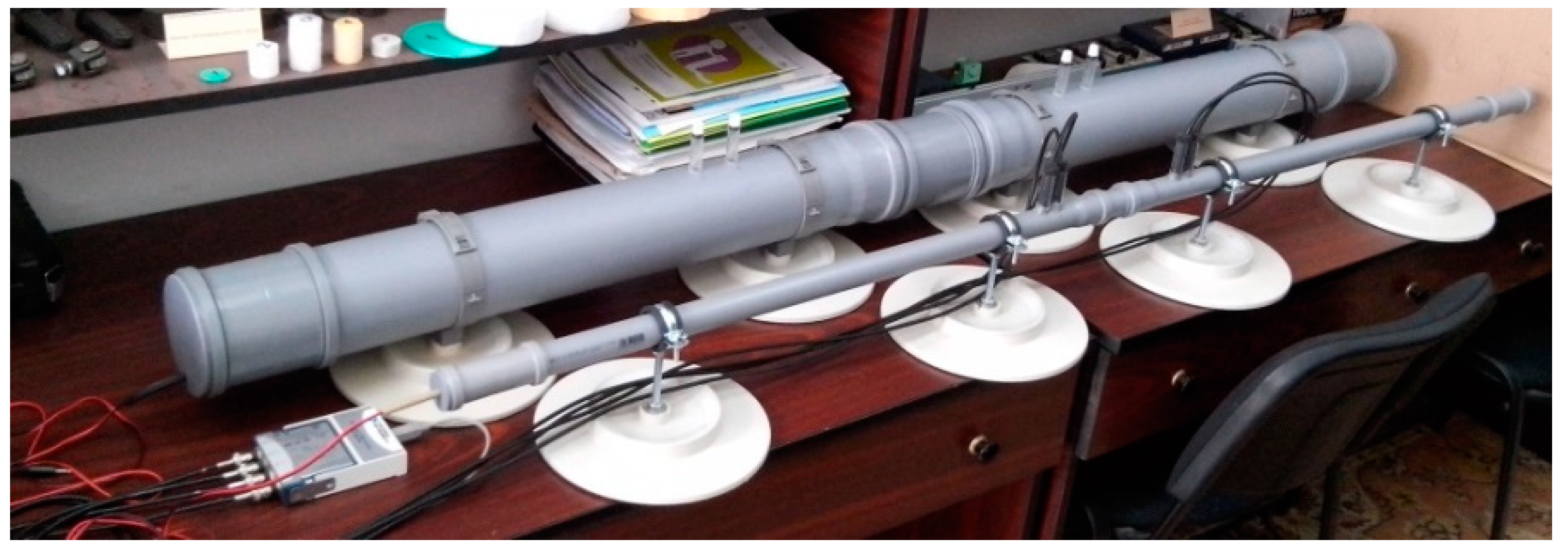




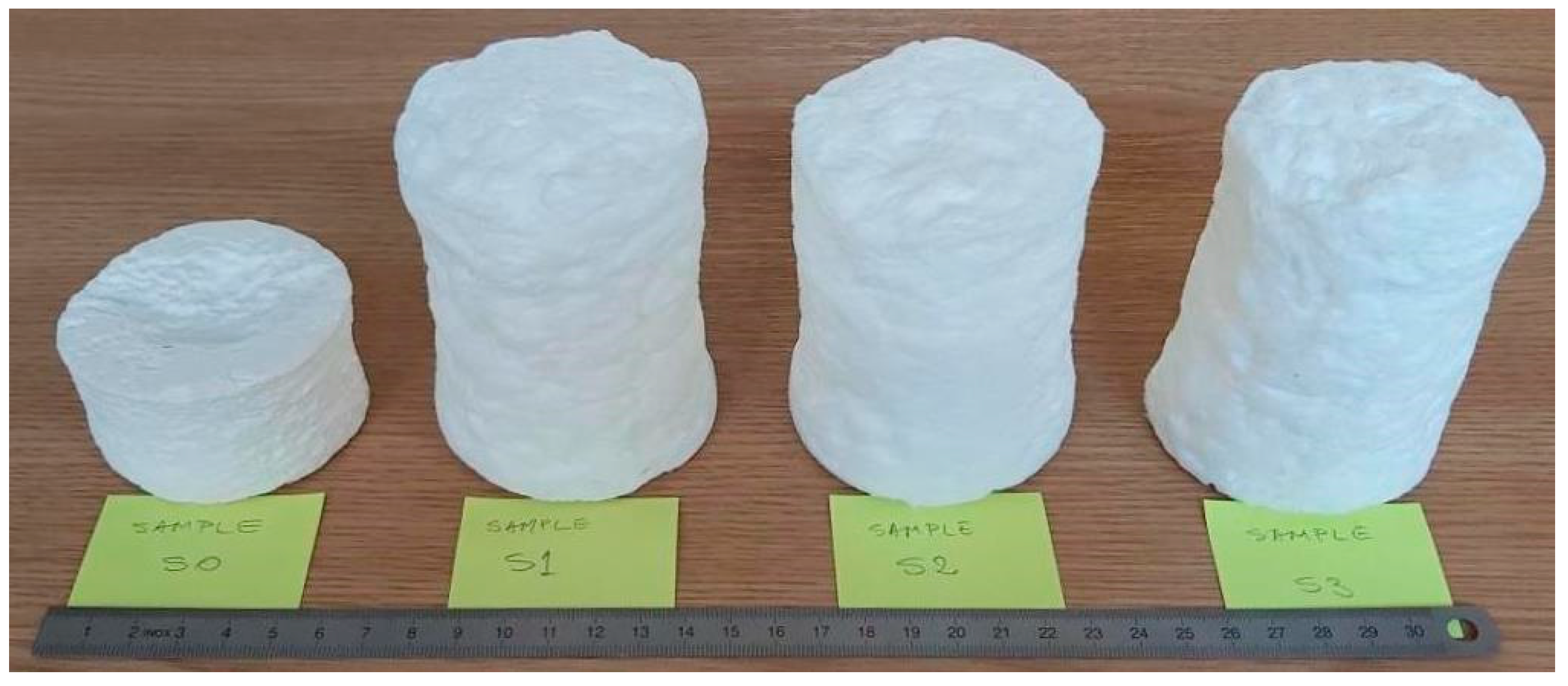
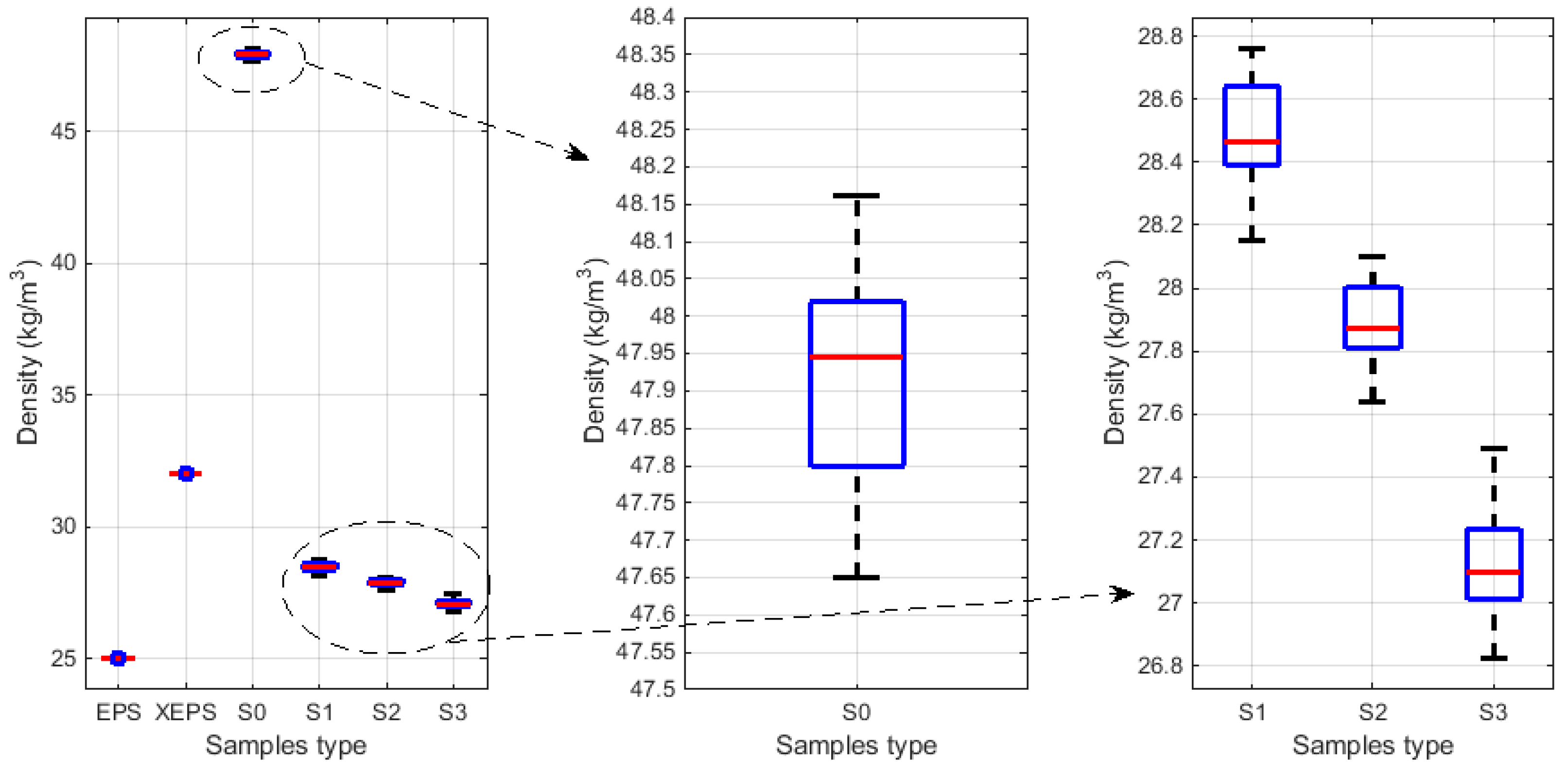
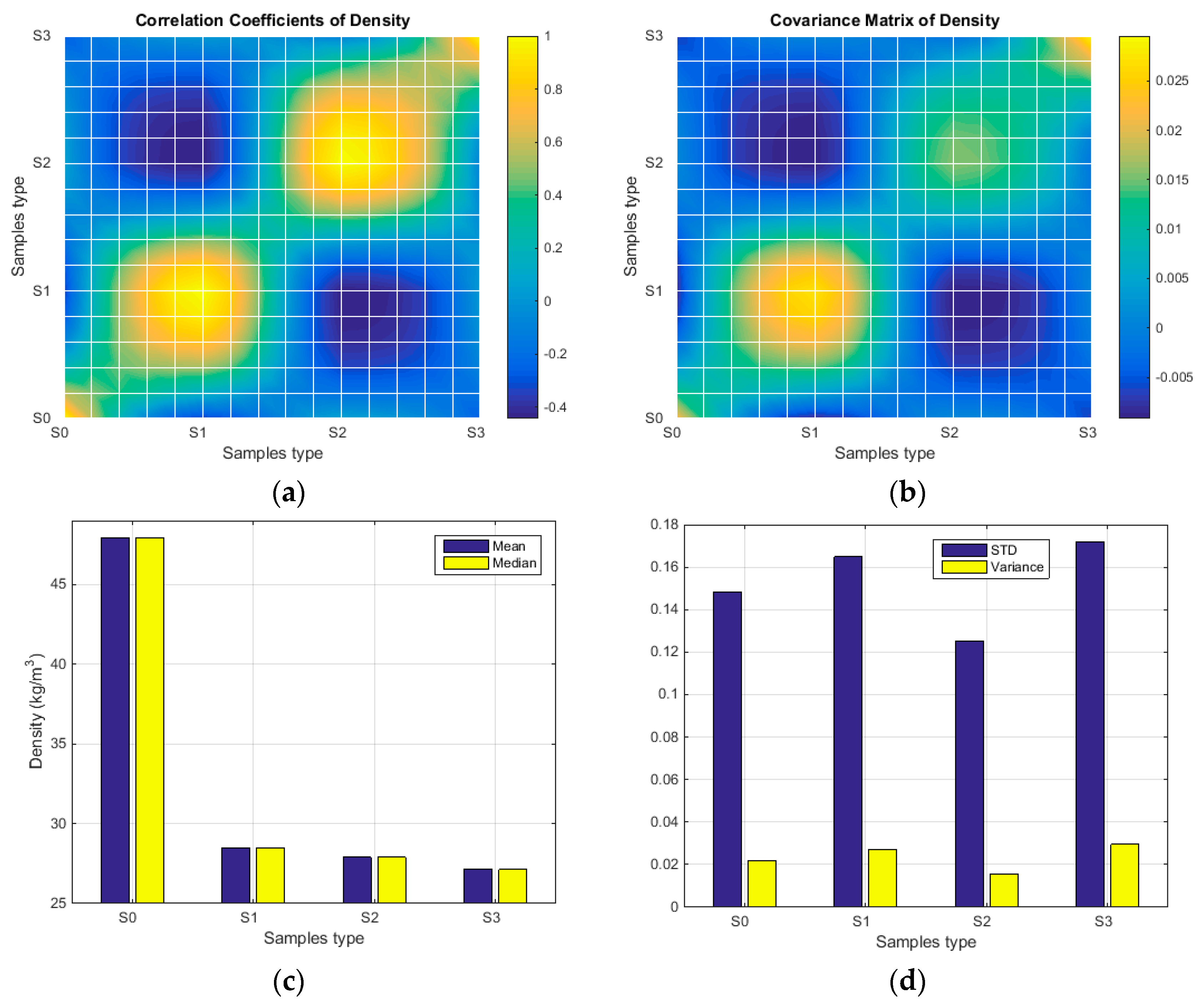

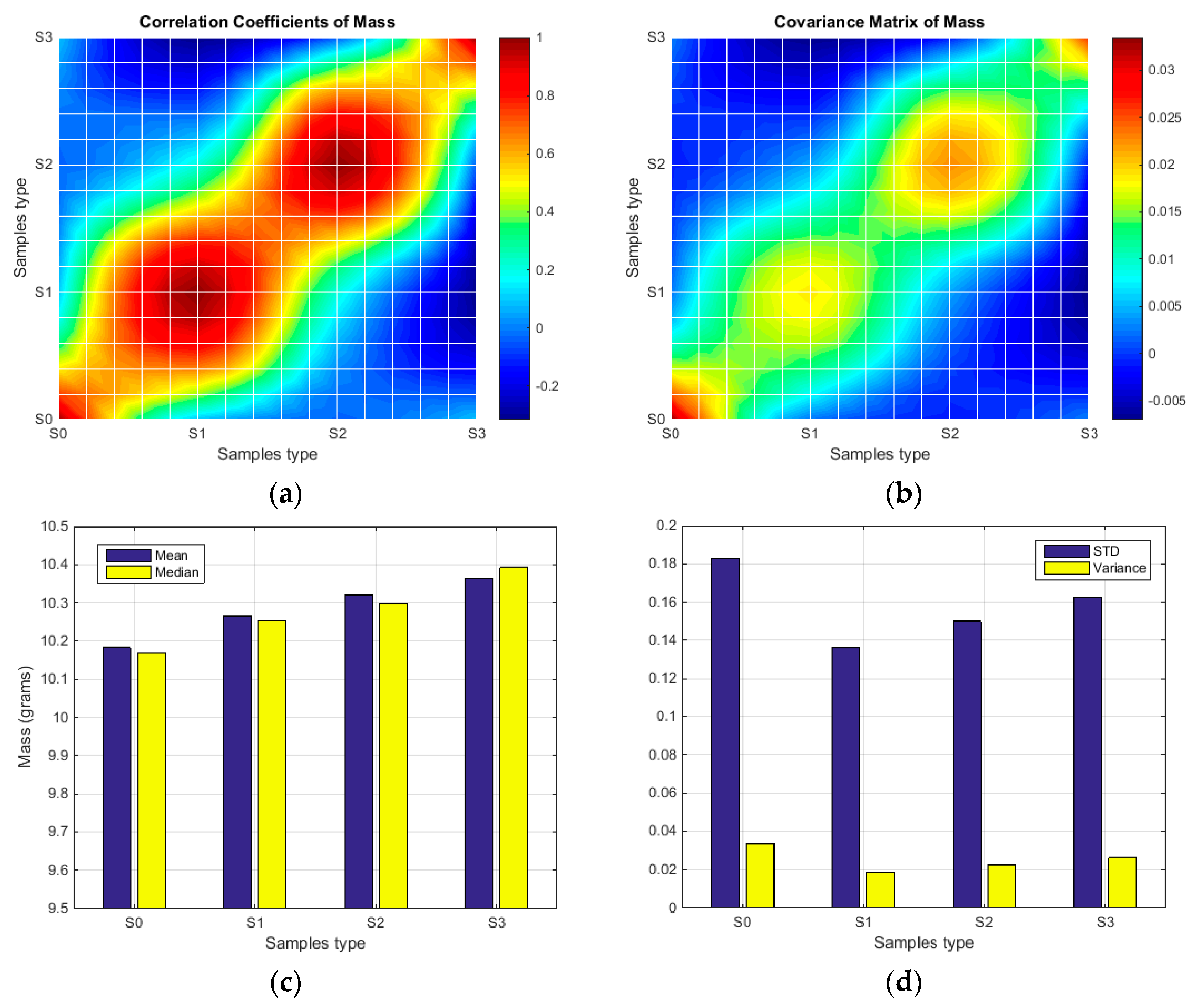

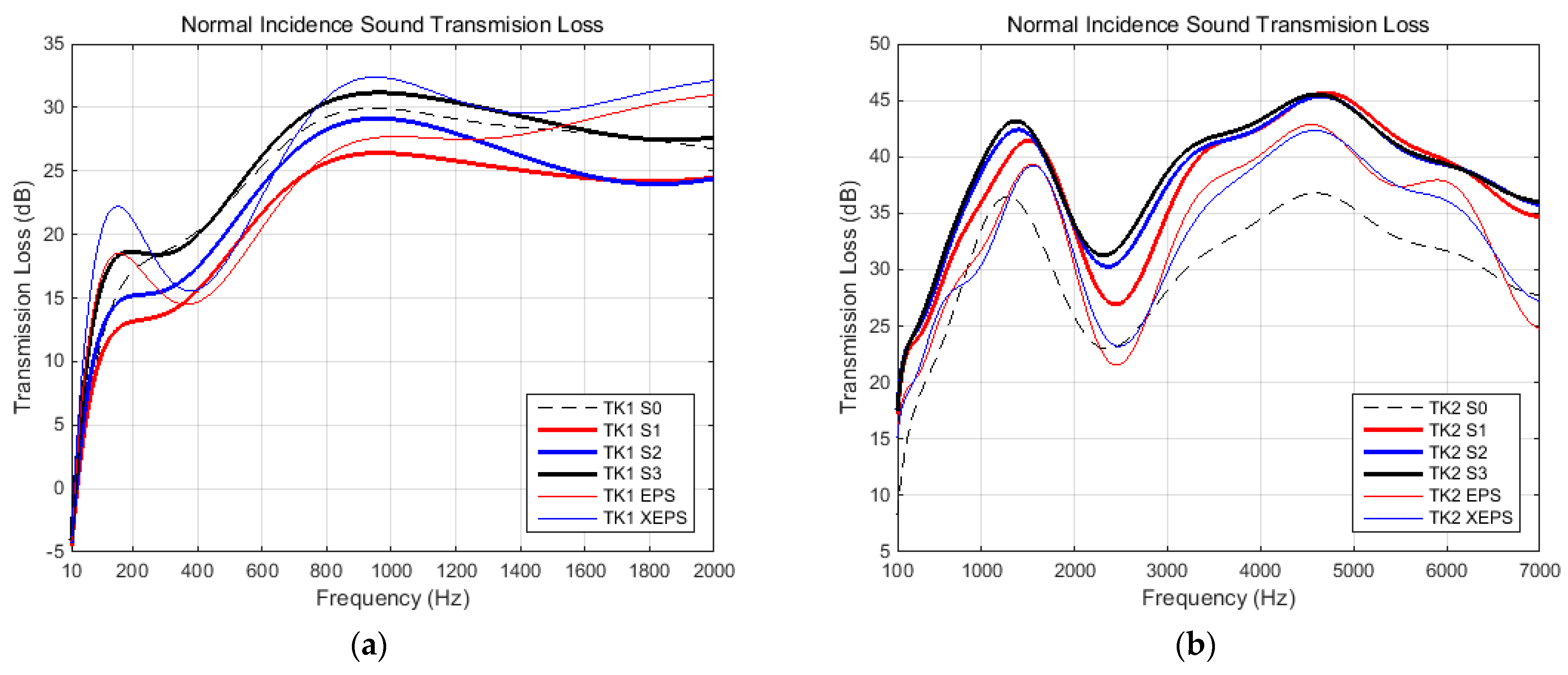
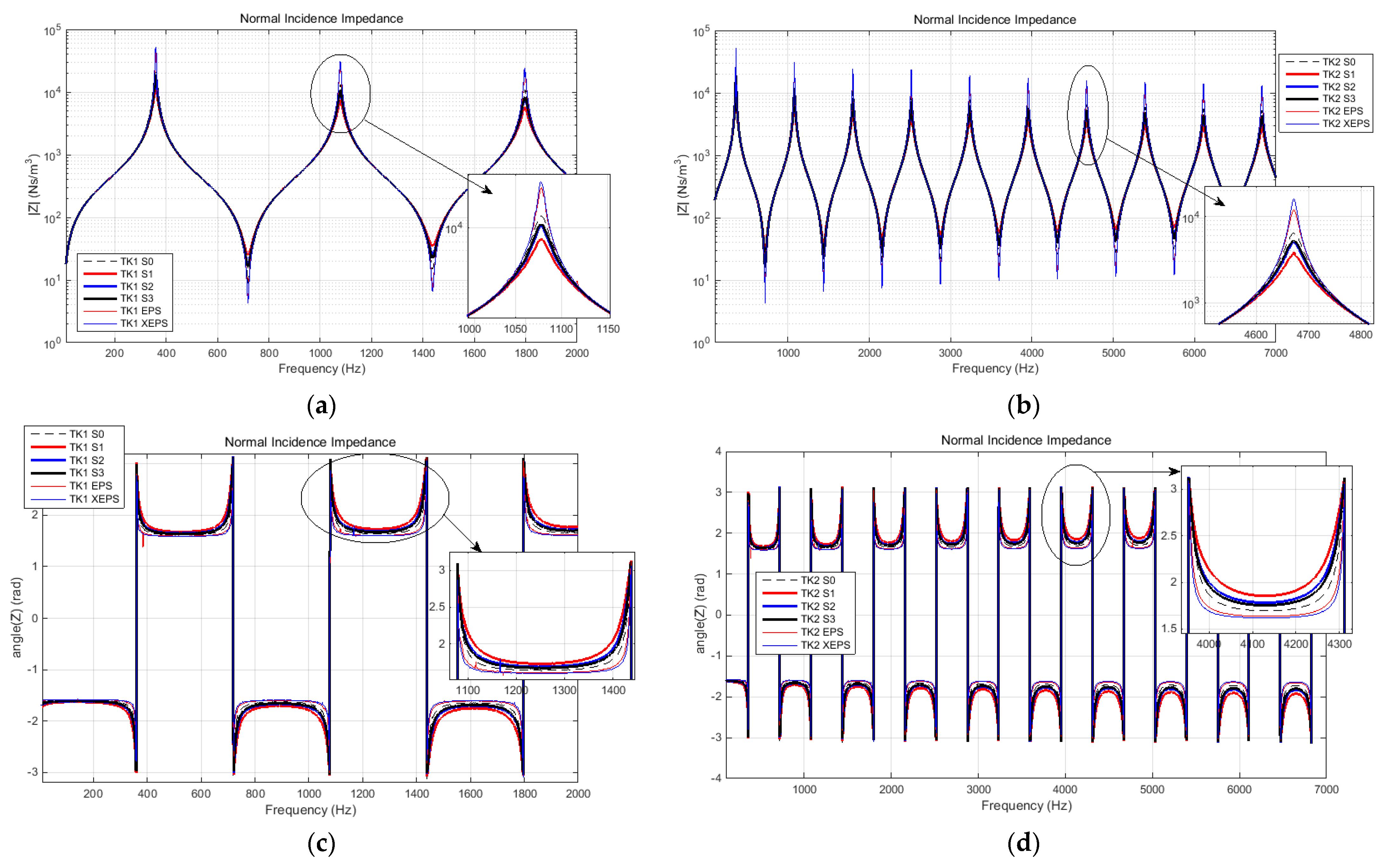
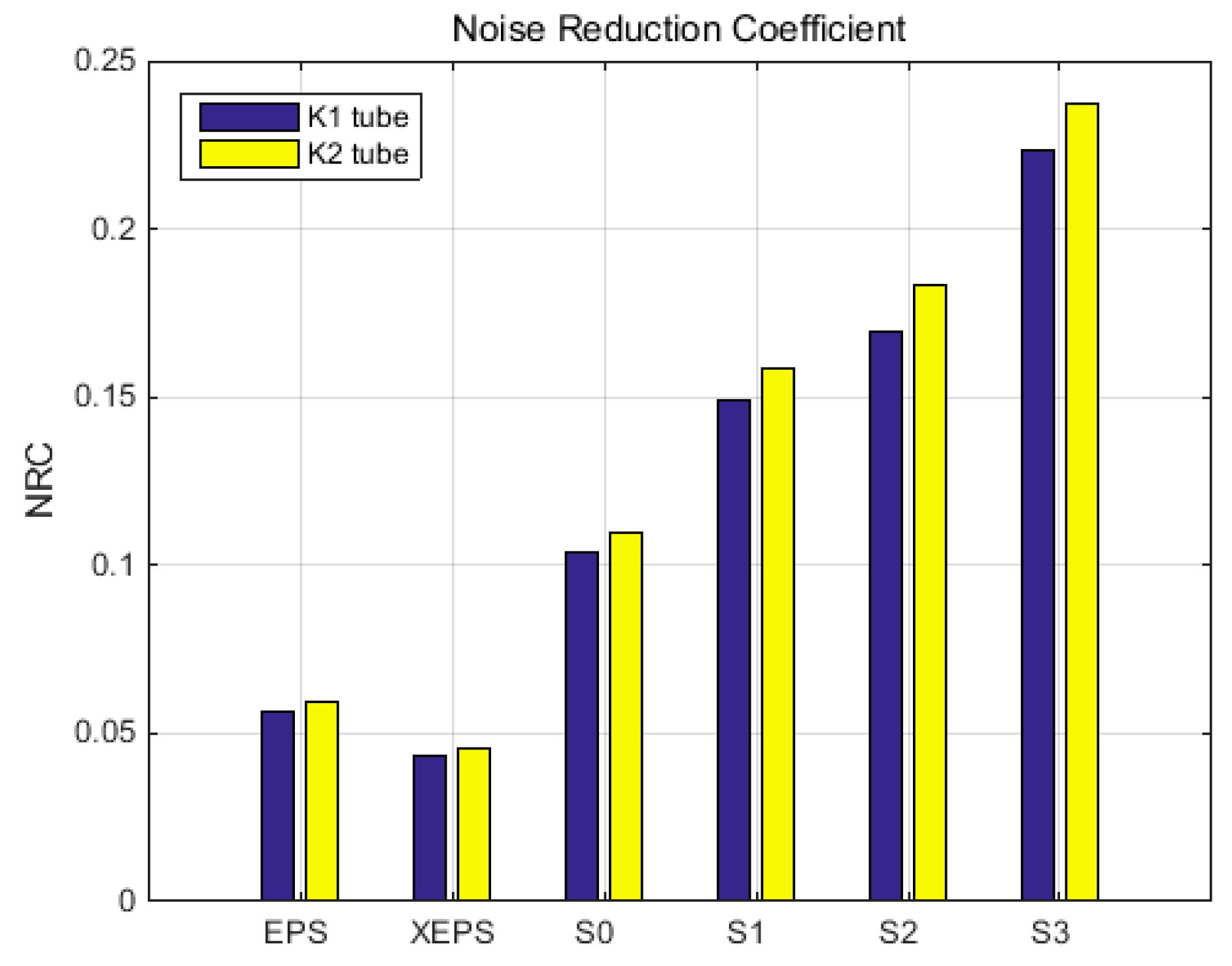
| Sample | Inital Volume (mL) | Final Volume 1 (mL) | Air Content (%) | STD |
|---|---|---|---|---|
| S1 | 500 | 710 | 42 | 0.122 |
| S2 | 500 | 760 | 52 | 0.141 |
| S3 | 500 | 800 | 60 | 0.135 |
| Sample | EPS | XEPS | S0 1 | S1 1 | S2 1 | S3 1 |
|---|---|---|---|---|---|---|
| Density (kg/m3) | 25.000 | 32.000 | 47.9095 | 28.4846 | 27.8818 | 27.1249 |
| Mass (×10−3 kg) | 9.969 | 12.760 | 10.183 | 10.265 | 10.322 | 10.366 |
| Sample | EPS | XEPS | S0 1 | S1 1 | S2 1 | S3 1 |
|---|---|---|---|---|---|---|
| NRC—tube K1 | 0.0566 | 0.0432 | 0.1037 | 0.1489 | 0.1696 | 0.2231 |
| NRC—tube K2 | 0.0594 | 0.0454 | 0.1099 | 0.1586 | 0.1832 | 0.2376 |
Disclaimer/Publisher’s Note: The statements, opinions and data contained in all publications are solely those of the individual author(s) and contributor(s) and not of MDPI and/or the editor(s). MDPI and/or the editor(s) disclaim responsibility for any injury to people or property resulting from any ideas, methods, instructions or products referred to in the content. |
© 2023 by the authors. Licensee MDPI, Basel, Switzerland. This article is an open access article distributed under the terms and conditions of the Creative Commons Attribution (CC BY) license (https://creativecommons.org/licenses/by/4.0/).
Share and Cite
Seciureanu, M.; Nastac, S.-M.; Guiman, M.-V.; Nechita, P. Cellulose Fibers-Based Porous Lightweight Foams for Noise Insulation. Polymers 2023, 15, 3796. https://doi.org/10.3390/polym15183796
Seciureanu M, Nastac S-M, Guiman M-V, Nechita P. Cellulose Fibers-Based Porous Lightweight Foams for Noise Insulation. Polymers. 2023; 15(18):3796. https://doi.org/10.3390/polym15183796
Chicago/Turabian StyleSeciureanu, Mihai, Silviu-Marian Nastac, Maria-Violeta Guiman, and Petronela Nechita. 2023. "Cellulose Fibers-Based Porous Lightweight Foams for Noise Insulation" Polymers 15, no. 18: 3796. https://doi.org/10.3390/polym15183796
APA StyleSeciureanu, M., Nastac, S.-M., Guiman, M.-V., & Nechita, P. (2023). Cellulose Fibers-Based Porous Lightweight Foams for Noise Insulation. Polymers, 15(18), 3796. https://doi.org/10.3390/polym15183796









